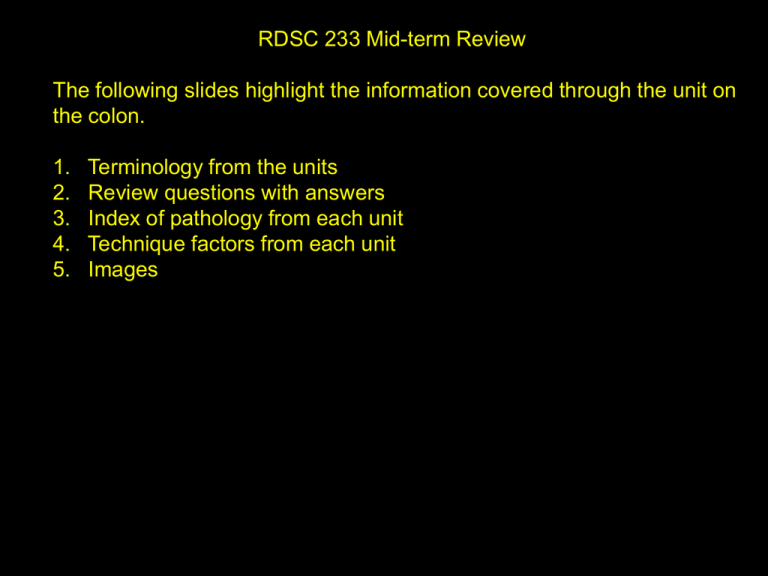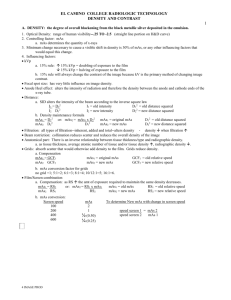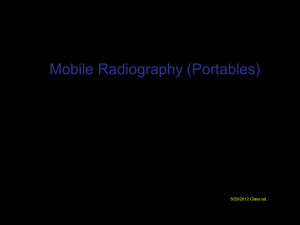Mid-term review
advertisement

RDSC 233 Mid-term Review The following slides highlight the information covered through the unit on the colon. 1. 2. 3. 4. 5. Terminology from the units Review questions with answers Index of pathology from each unit Technique factors from each unit Images Abdomen: distention flatulence flank stripes mass arteriosclerosis free air air fluid levels anomaly fecal stasis peritonitis adhesions volvulus intussusception aerophagia eructation vena cava filter pulmonary embolism Chest: nasogastric (NG) tube endotracheal (ET) tube SOB dyspnea angina sputum hemoptysis fibrile/afibrile aspiration chronic/acute heart mummer hyaline membrane disease empyema thoracocentesis pneumonectomy rales interstitium pulmonary edema subcutaneous emphysema Kerely B lines cardiomegaly neoplasm benign malignant crepitant situs inversus tracheostomy UGI: non per os (NPO) contraindication fistula collodial suspension MI N/V hematemesis retrogastric space motility series enteroclysis intubation valsalva maneuver reflux trendelenburg position asymptomatic Menkel’s diverticulum Single contrast colon: cathartic purgative proctology proctoscopy Air contrast colon: colonoscopy stenosed (stenosis) Sims position adenoma guaiac test sessile occult blood villous familial pedunculated sepsis carcinoma septacemia cytologic differentiated metastasis enteritis inflammatory bowel disease colitis Quiz Questions Name the 9 regions of the abdomen and pelvis 1 4 7 2 5 8 3 6 9 Y ( if needed to see) or N What can be visualized 10. 11. 12. 13. 14. 15. 16. 17. 18. 19. Gas? Urine? N Y N N Spleen Gallbladder Adrenal glands Stomach Veins kidneys Colon (gas) bladder Pancreas Ureters Liver Sm. Bowel Y Y What is normally visible 10. 11. 12. 13. 14. 15. 16. 17. 18. 19. Spleen Y Gallbladder N Adrenal glands N Stomach Y Veins N kidneys Y Colon (gas) Y bladder Y Pancreas N Ureters N Y ( if needed to see) or N Gas? Urine? N N N Y N N Y N N N N N N N N N N Y N N Abdomen Positioning 20. What anatomical landmark is used to center (longitudinally) a KUB film? And to what part of film (top, center, bottom) 21. What anatomical landmark is used to center (longitudinally) an upright of the abdomen? And to what part of film (top, center, bottom) 22-24. What 3 conditions can be demonstrated on the upright abdomen, in addition to what can be demonstrated on the supine KUB? (Two are shown here). Abdomen Positioning 20. What anatomical landmark is used to center (longitudinally) a KUB film? And to what part of film (top, center, bottom) Iliac Crest, center 21. What anatomical landmark is used to center (longitudinally) an upright of the abdomen? And to what part of film (top, center, bottom) Axilla, top 22-24. What 3 conditions can be demonstrated on the upright abdomen, in addition to what can be demonstrated on the supine KUB? (Two are shown here). Air fluid levels Free air in the abdomen (pneumoperitoneum) Ptosis Radiographic Anatomy of PA Chest 30 25 28 26 27 31 29 Radiographic Anatomy of PA Chest 30 Hilum of Lt lung 25 Lung markings 26 Rt. Pulmonary a. 28 Aortic knob 27 Rt cardiophrenic angle 31 Lt costophrenic angle 29 Dome of the Rt hemidiaphragm Define: 1 32. 33. 34. 35. dyspnea angina sputum fibrile Short answer: 36. How many ribs must be demonstrated on an inspiration PA CXR, and is it anterior or posterior ribs that are counted? Define: 32. dyspnea – difficulty breathing 33. angina – chest pain (lt arm, neck) 34. sputum – pus/debris from deep in bronchial tree & alveoli 35. fibrile - fever Short answer: 36. How many ribs must be demonstrated on an inspiration PA CXR, and is it anterior or posterior ribs that are counted? 10, posterior Review of PA Film Critique On all films Patient ID Rt or Lt marker Contrast & density Motion Artifacts PA chest criteria 37. 38. 39. 40. 41. Review of PA Film Critique On all films Patient ID Rt or Lt marker Contrast & density Motion Artifacts PA chest criteria 37. Clipping 38. Inspiration 39. Rotation 40. Scapula free of lung fields 41. Penetration of mediastinum 42. Name this position 43. If only a tube angle is used to accomplish it, what is the degree and direction of the CR? 44. Name this position 45. What pathological condition would be demonstrated on the up side? 46. What pathological condition would be demonstrated on the down side? 42. Name this position Apical lordotic (lordotic chest) 43. If only a tube angle is used to accomplish it, what is the degree and direction of the CR? 15-200 cephalad 44. Name this position (Rt) lateral decubitus 45. What pathological condition would be demonstrated on the up side? Pneumothorax 46. What pathological condition would be demonstrated on the down side? Pleural effusion 48. 47. In which body habitus would the stomach lie in this extreme transverse position? 50. 49. 48. 2nd or descending part of d. 47. In which body habitus would the stomach lie in this extreme transverse position? hypersthenic 50. Greater curvature of s. 49. pyloric antrum 51. What is the atomic number of barium? 52. True or false: Barium is Insoluble in water. 53. Is this film AP, PA, or RAO? 54. Is this film AP, PA, or RAO? 55. Is this film AP, PA, or RAO? 56. What is the range of obliquity for an RAO stomach? 57. What body habitus requires the steepest obliquity? 51. What is the atomic number of barium? 56. 52. True or false: Barium is Insoluble in water. True 53. AP 54. PA 55. RAO 56. What is the range of obliquity for an RAO stomach? 40700 57. What body habitus requires the steepest obliquity? Hypersthenic 58. “Rule out MI” is sometimes given as the reason for an UGI. What is an MI? 59. What UGI projection best demonstrates the retrogastric space? 60. What is the range of obliquity for the LPO position of the stomach? 61. Name one reason that barium would be contraindicated for use in the GI tract. 62. The spot film shown here is generally taken as the film of what examination? 58. “Rule out MI” is sometimes given as the reason for an UGI. What is an MI? Myocardial infarction, or heat attack. 59. What UGI projection best demonstrates the retrogastric space? Rt lateral 60. What is the range of obliquity for the LPO position of teh stomach? 30-600 61. Name one reason that barium would be contraindicated for use in the GI tract. Perforated bowel, post surgical, or, obstruction 62. The spot film shown here is generally taken as the film of what examination? Small bowel series (SBS) Small bowel follow through (SBFT) Motility series Radiographic Anatomy of the colon 63. 64. The folds that create the characteristic appearance of the colon 67 66 65. 68 Radiographic Anatomy of the colon 63. Hepatic (Rt. colic) flexure 64. Haustra (haustral folds, haustrations) 67. Descending c. 66. Terminal ileum 65. Cecum 68. Rectum 69. Other than laxative, what other name is given a medicinal preparation that stimulates the bowel to evacuate, and is so used for a bowel prep? (2 possibilities) 70. What is the name of the position used for enema tip insertion? 71. Is this position a steep RAO, LAO, RPO, or LPO? 72. Approximately how high above the table should be barium bag be hanging? 73. The terms septic and sepsis refer to: a. infection b. wall or division between parts c. toxic chemicals d. gangrene 69. Other than laxative, what other name is given a medicinal preparation that stimulates the bowel to evacuate, and is so used for a bowel prep? (2 possibilities) Cathartic or purgative 70. What is the name of the position used for enema tip insertion? Sims 71. Is this position a steep RAO, LAO, RPO, or LPO? LAO 72. Approximately how high above the table should be barium bag be hanging? 2 feet 73. The terms septic and sepsis refer to: a. infection b. wall or division between parts c. toxic chemicals d. gangrene 74. Septacemia 75. Ileostomy, jejunostomy, colostomy 76. Stoma 77. Resection 78. Anastomosis 79. Glucagon 74. Septacemia – Pathogenic microorganisms in the blood. 75. Ileostomy, jejunostomy, colostomy – ostomy = a surgically formed fistula, most commonly between intestine and the abdominal wall. (vs. otomy = surgical incision, vs. ectomy = removal) 76. Stoma – A mouth like artificial opening between two body cavities, or a passageway between a cavity and a body surface 77. Resection – partial excision of a part. 78. Anastomosis – natural or surgical connection between two tubular structures 79. Glucagon – Hormone secreted by alpha cells of pancreas that stimulates liver to change stored glycogen to glucouse. Parentaral administration relaxes smooth muscles of alimentary tract. Significant Pathologies or Pathologic Indicators of the abdomen and their Radiographic Appearances Mass Institutional colon Pneumoperitoneum Ascites Ileus Significant Pathologies of the lungs, thorax, and mediastinal structures and their Radiographic Appearances Aneurysm Pleural Effusion Pneumothorax Pneumoconiosis Atelectasis Granulomatous disease Congestive heart failure (CHF) COPD (Bronchitis and emphysema) Significant Pathologies of the upper gastrointestinal tract and their Radiographic Appearances Thoracic stomach Diverticula Ulcerations Significant Pathologies of the colon and their Radiographic Appearances Diverticulosis Abdominal hernias Tape worms Polyps Colorectal Cancer Chron’s disease Intussusception Institutional colon Exposure Factors From the “Rules of Thumb” Based on: 3 phase, 100 RS film, 12:1 grid, 40” SID Abdomen/Pelvis Frontal (2 x cm) + 35 =kVp @ 50 mAs Lateral (4x frontal) (AP + 10 kVp @ 100 mAs Oblique (AP + 40% - 60% of frontal technique Exposure Factors From the “Rules of Thumb” Based on: 3 phase, 100 RS film, 40” SID Maternal Abdomen On occasion a radiograph of the pregnant abdomen is ordered during labor, to check for a breech presentation. Every radiology department should have at least one high speed film/screen system for this purpose. What is required in terms of kVp and mAs? High kVp (110 or higher), low mAs. Exposure Factors From the “Rules of Thumb” Based on: 3 phase, 400 RS film, 40” SID Calculate a maternal abdomen technique for a 35 cm measurement 1. (2 x 35) + 35 = 105 kVp @ 50 mAs 2. 40 mAs / 4 = 12.5 mAs (film speed) 3. 15% of 105 = 16.5 = Answer 121 kVp @ 6 mAs Critique critera: For presentation, only gross anatomy need be visualized. Maternal abdomen films are rarely repeated. Exposure Factors From the “Rules of Thumb” Based on: 3 phase, 100 RS film, medium speed screen, 72” SID PA Chest: Lat Chest: 2 x cm + 35 = kVp @ 5 mAs PA kVP + 10 @ mAs x 2 Chest radiography may be done screen or grid, dependant on department protocol and circumstance, e.g. surgical or portable. When done screen What must be set to use AEC? Advantage is: lower kVp = greater contrast Disadvantage is: lower kVp = less penetration1. kVp When done grid Disadvantage is: high kVp = less contrast Advantage is: high kVp = greater penetration 2. 3. 4. 5. mA Chambers Back up time + or – density Exposure Factors From the “Rules of Thumb” Based on: 3 phase, 100 RS film, medium speed screen, 72” SID Compute a technique for a double contrast, and single contrast UGI for a 26 cm abdomen in an AP position, using 400 RS system 1. (2 x 26) + 35 = 87 kVP @ 50 mAs 2. 50 mAs / 4 (RS) = 87 kVp @ 12.5 mAs (Double contrast) 3. 87 + 13 = 100 kVp @ 6 mAs (Single Contrast) Now put the patient in an RAO (single contrast) Up AP technique by 40 – 60 % = 108 kVp at 6 mAs Now put the patient in a right lateral (double contrast) Up AP kVp by 10, double mAs = 97 kVp @ 25 mAs Exposure Factors From the “Rules of Thumb” Based on: 3 phase, 100 RS film, 40” SID, 12:1 grid Colon: Use computation for abdomen, except, kVp above 100 for barium Problem: For a patient with an AP diameter of 25 cm at the level of the umbilicus, using a 400 RS screen/film combination, what techniques would be used for: AP Oblique Axial sigmoid views & Lateral rectum Exposure Factors From the “Rules of Thumb” Based on: 3 phase, 100 RS film, 40” SID, 12:1 grid Problem: For a patient with an AP diameter of 27 cm at the level of the umbilicus, using a 400 RS screen/film combination, what techniques would be used for: AP 89 kVp @50 (KUB technique) 89 kVp @12.5 (400 RS) 103 kVp @12.5 (15% rule to increase kVp) Oblique 103 kVp @19 120 kVp @ 12.5 (50% increase taken in mAs) or (50% increase taken in kVp) Exposure Factors From the “Rules of Thumb” Based on: 3 phase, 100 RS film, 40” SID, 12:1 grid Problem: For a patient with an AP diameter of 27 cm at the level of the umbilicus, using a 400 RS screen/film combination, what techniques would be used for: Axial sigmoid is same as oblique technique 103 kVp @19 120 kVp @ 12.5 (50% increase taken in mAs) or (50% increase taken in kVp) Lateral rectum 103 kVp @ 12.5 50 118 kVp @ 25 mAs (AP technique) (2 x kVp and 2 x mAs) Note: for a KUB the kVp rule was increase by 10, but that was in the 70-80 kVp range to start with. Exposure Factors From the “Rules of Thumb” AEC is sometimes used for barium studies, and is usually successful. When using AEC for barium studies the centering of the chamber or chambers over solid barium or solid air will lead to films that are too light or too dark. Using multiple results in an average of the densities sampled, and lessens the possibility of error. Plus and minus density may be needed for some views






